Falmouth
| Falmouth | |
| Cornwall | |
|---|---|
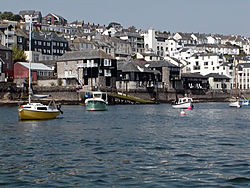 Falmouth Harbour | |
| Location | |
| Grid reference: | SW810325 |
| Location: | 50°9’7"N, 5°3’55"W |
| Data | |
| Population: | 21,635 (2001) |
| Post town: | Falmouth |
| Postcode: | TR11 |
| Dialling code: | 01326 |
| Local Government | |
| Council: | Cornwall |
| Parliamentary constituency: |
Truro and Falmouth |
Falmouth is a port town on the River Fal on the south coast of Cornwall. It has a total resident population of 21,635.[1]
The name Falmouth comes from the river Fal but the origin of the river's name is unknown. Falmouth is the end point of the A39 road which begins some 200 miles away in Bath, Somerset.
Falmouth harbour
Falmouth harbour together with Carrick Roads forms the third deepest natural harbour in the world, and the deepest in Western Europe.[2] The harbour is famous as the start or finish point of various round-the-world record-breaking voyages, such as those of Sir Francis Chichester and Dame Ellen MacArthur. Falmouth Docks Police provide policing for the docks.
Many yachts are to be found moored in Falmouth harbour in addition to commercial shipping.
Churches
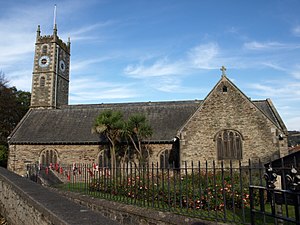
The parish church is the Church of King Charles the Martyr, a rare dedication.
The church was built after the Civil War and the Restoration, when Sir Peter Killigrew gave land for the building of the church. Part of the cost was paid by King Charles II, and it received a dedication to the King's late father, King Charles I, considered to have died a martyr of the Church of England.
History
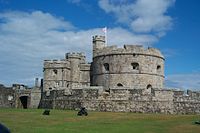
Falmouth was originally named Peny-cwm-cuic ("head of the valley of the village"), which later became 'Pennycomequick'.[3] King Henry VIII built a new castle, Pendennis Castle, at Pennycomequick to defend Carrick Roads in 1540, at which time the main town was at Penryn. In the late 16th century, under threat from the Spanish Armada, the defences at Pendennis were strengthened by the building of angled ramparts.
Sir John Killigrew created the town of Falmouth shortly after 1613.[4] During the Civil War, Pendennis Castle was the last fort but one to surrender to the Parliamentary Army.[5]
After the Civil War, Sir Peter Killigrew received gave land for the building of the parish church, dedicated to King Charles I, "the Martyr", which received royal patronage and a grant of money from the King and from his brother the Duke of York.
The Falmouth Packet Service operated out of Falmouth for over 160 years between 1689 and 1851. Its purpose was to carry mail to and from Britain's growing empire. As the most south-westerly good harbour in Great Britain Falmouth was often the first port for returning ships of the Royal Navy.
19th & 20th centuries
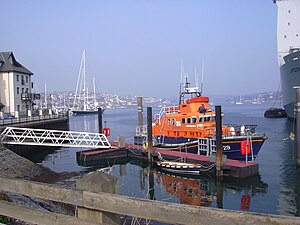
The news of Britain's victory at Trafalgar was landed here from the schooner Pickle and taken to London by stagecoach.
On 2 October 1836 HMS Beagle anchored at Falmouth at the end of its famous survey voyage round the world[6] and landed Charles Darwin to head home to Shrewsbury.[7]
The Falmouth Docks were developed from 1858,[8] and the Royal National Lifeboat Institution opened Falmouth Lifeboat Station nearby in 1867. The present building dates from 1993 and jointly houses Her Majesty's Coastguard.[9] The RNLI operates two lifeboats from Falmouth: Richard Cox Scott, a 56-foot Severn Class all-weather boat, and Eve Park, an Atlantic 75 inshore lifeboat.[10]
The Cornwall Railway reached Falmouth on 24 August 1863. The railway brought new prosperity to Falmouth, as it made it easy for tourists to reach the town. It also allowed the swift transport of the goods recently disembarked from the ships in the port. The town now has three railway stations. Falmouth Docks railway station is the original terminus and is close to Pendennis Castle and Gyllyngvase beach. Falmouth Town railway station was opened on 7 December 1970 and is convenient for the National Maritime Museum Cornwall, the waterfront, and town centre. Penmere railway station opened on 1 July 1925 towards the north of Falmouth and within easy walking distance of the top of The Moor. All three stations are served by regular trains from Truro on the Maritime Line. Penmere Station was renovated in the late 1990s, using the original sign and materials, and is now a fine example of an early 20th century railway station.
During Second World War, 31 people were killed in Falmouth by German bombing. It was also the launching point for the famous Commando raid on St Nazaire. An anti-submarine net was laid from Pendennis to St Mawes, to prevent enemy U-boats entering the harbour.
Economy, industry and tourism
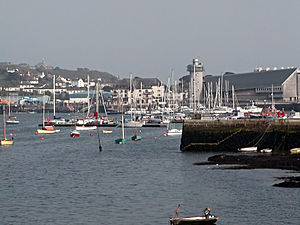
If declined from their heyday, the Falmouth docks are still a major contributor to the town's economy. It is one of the largest ports in Cornwall. Falmouth is still a cargo port and the bunkering of vessels and the transfer of cargoes also keep the port's facilities busy. The port is also becoming popular with cruise ship operators. Sixty-four cruise ships were due in Falmouth in 2007.
Further up the sheltered reaches of the Fal there are several ships laid up, awaiting sailing orders.
Many of Falmouth's Georgian town houses have been converted into guest houses and small hotels, often overlooking one of the beaches. Falmouth has proven a popular holiday destination and it is now primarily a tourist resort. The five main beaches starting next to Pendennis Castle and moving along the coast towards the Helford river are Castle, Tunnel, Gyllyngvase, Swanpool and Maenporth beaches.
The National Maritime Museum Cornwall opened in February 2003. The building was designed by the architect MJ Long.[11]
Culture
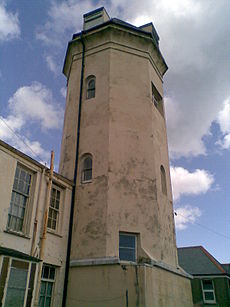
Falmouth has many literary connections. The town was the birthplace of Toad, Mole and Rat: Kenneth Grahame's classic Wind in the Willows, begun as a series of letters sent to his son. The first two were written at the Greenbank Hotel whilst Grahame was a guest in May 1907. Reproductions of the letters are currently on display in the hotel. Poldark author Winston Graham knew the town well and set his novel The Forgotten Story (1945) in Falmouth.
The Falmouth Art Gallery, a public gallery, has a diverse nineteenth century and twentieth century art collection including many notable modern Cornish artists exhibited in four to five seasonal exhibitions a year, as well as a "family friendly and free" community and schools education programme.
Recreation
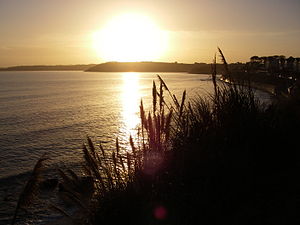
With its proximity to sheltered and unsheltered waters, Falmouth has long been a popular boating and water sports location. Solo yachtsman Robert Manry crossed the Atlantic from Falmouth, Massachusetts to Falmouth, Cornwall from June-August 1965 in the thirteen and a half foot Tinkerbelle - this was the smallest boat to make the crossing at the time. The town was the location for the 1998 Tall Ships' Race in which approximately ninety Tall Ships set sail for Lisbon. It also saw total coverage of the total eclipse of the sun at 11:11 am on 11 August 1999 where the eclipse lasted just over two minutes; the longest duration in the UK.
Picture gallery
-
Admiralty House, Arwenack Street
-
Passmore Edwards Free Library
-
All Saints Church, Killigrew Street
-
Roman Catholic Church of St Mary Immaculate
-
Central Methodist Church
-
Old Constabulary
-
Old Drill Hall, Brook Street
-
St Michael and All Angels Church, North Parade, Penwerris
References
- ↑ "Key Statistics for urban areas in England and Wales" (PDF). National Office of Statistics. 2004. http://www.statistics.gov.uk/downloads/census2001/ks_ua_ew_part1.pdf. Retrieved 2008-01-13.
- ↑ "About Falmouth". Falmouth Town Council. http://www.falmouthtowncouncil.co.uk/index.php?name=News&file=article&sid=17. Retrieved 2009-06-03.
- ↑ "Falmouth Town". GenUKi. http://www.genuki.org.uk/big/eng/Cornwall/Falmouth/index.html. Retrieved 2008-07-14.
- ↑ "Falmouth 1837". Old Towns of England. http://www.oldtowns.co.uk/Cornwall/falmouth.htm. Retrieved 2007-05-25.
- ↑ "Castle recreates Civil War strife". BBC News. 2006-08-19. http://news.bbc.co.uk/1/hi/england/cornwall/5266208.stm. Retrieved 2010-12-10.
- ↑ FitzRoy, Robert (1839). Narrative of the surveying voyages of His Majesty's Ships Adventure and Beagle between the years 1826 and 1836, describing their examination of the southern shores of South America, and the Beagle's circumnavigation of the globe. Appendix to Volume II. London: Henry Colburn. http://darwin-online.org.uk/content/frameset?itemID=F10.2a&viewtype=text&pageseq=1.
- ↑ Keynes, R. D. (2001). Charles Darwin's Beagle diary. Cambridge University Press. pp. 447. http://darwin-online.org.uk/content/frameset?viewtype=text&itemID=F1925&pageseq=479.
- ↑ "Falmouth Docks". Falmouth Packet Archives 1688-1850. http://www.falmouth.packet.archives.dial.pipex.com/id121.htm. Retrieved 2008-07-14.
- ↑ Morris, Jeff (2002). The History of the Falmouth Lifeboats (2nd ed.). Coventry: Lifeboat Enthusiast's Society.
- ↑ Denton, Tony (2009). Handbook 2009. Shrewsbury: Lifeboat Enthusiasts Society.
- ↑ "Falmouth International Maritime Initiative". Long/Kentish Practice. Archived from the original on 2008-04-02. http://web.archive.org/web/20080402074955/http://www.longkentish.com/projects.htm. Retrieved 2008-07-14.
Outside links
| ("Wikimedia Commons" has material about Falmouth) |








